BEES Students Show Off Their Research Mussels
By Roger Thomas
 Kathryn Longwill, MS ENVS ’14, and Lexi Wysocki, BS ENVS ’22, add juvenile mussels to a floating basket prior to installing it at Green Lane Reservoir. Credit: Roger L. Thomas
Kathryn Longwill, MS ENVS ’14, and Lexi Wysocki, BS ENVS ’22, add juvenile mussels to a floating basket prior to installing it at Green Lane Reservoir. Credit: Roger L. Thomas
October 14, 2020
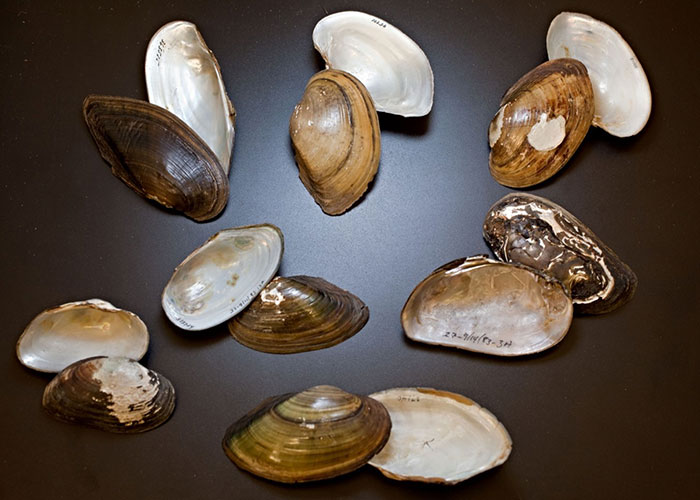 Freshwater mussel historically found in the Delaware River watershed (top) Eastern Pondmussel, Tidewater mucket, and Yellow Lampmussel, (middle) Creeper, Eastern Floater, and Eastern Elliptio, and (bottom) Alewife floater.
Credit: David M. Warren/Philadelphia Inquirer
Freshwater mussel historically found in the Delaware River watershed (top) Eastern Pondmussel, Tidewater mucket, and Yellow Lampmussel, (middle) Creeper, Eastern Floater, and Eastern Elliptio, and (bottom) Alewife floater.
Credit: David M. Warren/Philadelphia Inquirer
For students in the Department of Biodiversity, Earth and Environmental Science (BEES), showing off their “research mussels” is just another day in the field. Their research mussels, namely freshwater mussels, are part of a decades-long research initiative championed by the Academy of Natural Sciences (ANS) and other partner organizations. For over forty years, scientists at ANS have been involved in freshwater mussel studies from Pennsylvania to South Carolina to Texas, and many points in between. Researchers have been wading into small streams and large rivers, frequently with a SCUBA tank strapped to their backs, trying to find these elusive bivalves.
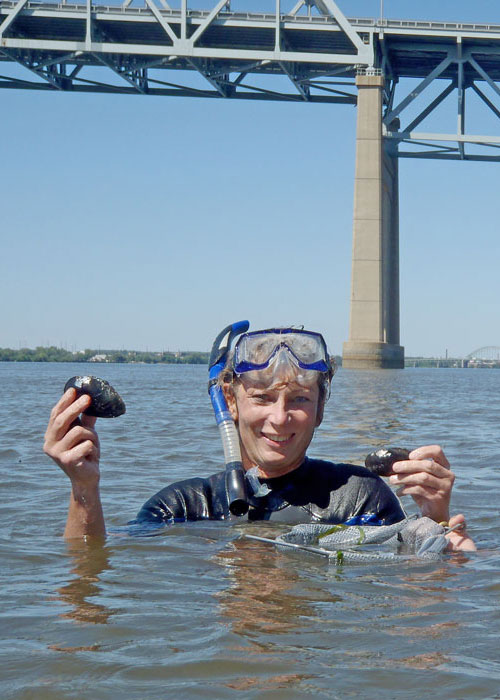 Dr. Danielle Kreeger, Science Director for PDE and BEES Associate Research Professor, collecting mussels from sites along the Delaware River. Credit: Roger L. Thomas
Dr. Danielle Kreeger, Science Director for PDE and BEES Associate Research Professor, collecting mussels from sites along the Delaware River. Credit: Roger L. Thomas
This team, including many BEES co-ops, graduate students and alumni, has traveled around southeastern Pennsylvania searching for mussels in local streams and the Schuylkill and Delaware Rivers to propagate these tiny mussels at The Mussel Hatchery at the Fairmount Water Works, and eventually grow them out at Longwood Gardens, Winterthur, and the Van Sciver and Green Lane reservoirs.
More recently in the past twenty years, a team of mussel researchers from the Academy, Drexel, the Partnership for the Delaware Estuary (PDE), Philadelphia Water Department (PWD), EPA Region 3 and the Western Pennsylvania Conservancy have collaborated on numerous few mussel monitoring, restoration and propagation projects more locally.
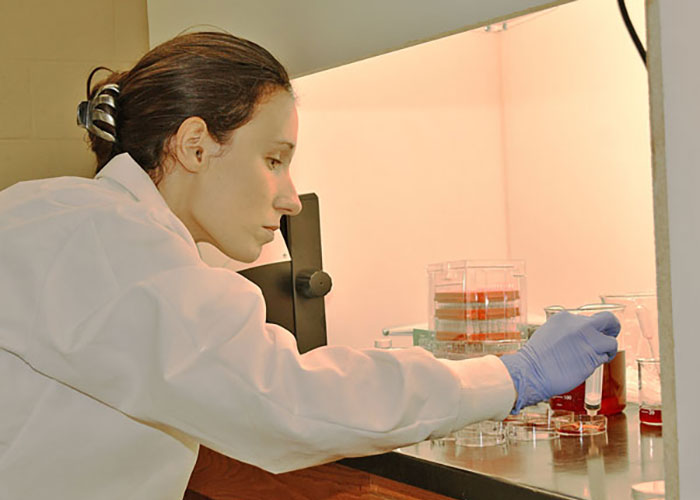 Kathryn Longwill preparing microscopic mussels for culturing. Credit: Roger L. Thomas
Kathryn Longwill preparing microscopic mussels for culturing. Credit: Roger L. Thomas
Small mussels have even been grown at the labs in the Academy. The juvenile mussels that were moved to these nursery facilities have grown considerably over the past two to three years. The results are very encouraging and demonstrate that these bodies of water have good water quality and plenty of food for mussels.
Mussels are incredible animals that provide many invaluable “ecosystem services.” They can filter up to ten to fifteen gallons of water each day — removing particles with potential contaminants and helping to make streams and rivers clearer. When mussel densities are high enough, they can also stabilize stream-bottom sediments when water levels increase. Lastly, mussel beds provide security for other macroinvertebrates and fishes who like to hide among their shells.
 The aquaria on the left has no mussels, the one on the right has many mussels filtering its water. After three hours, you can see the difference. Imagine how much a large bed of mussels could filter in your local stream. Credit: Angela Padeletti
The aquaria on the left has no mussels, the one on the right has many mussels filtering its water. After three hours, you can see the difference. Imagine how much a large bed of mussels could filter in your local stream. Credit: Angela Padeletti
Of the nearly 300 species of freshwater mussels that can be found in the U..S, approximately 70% are either threatened or endangered, making them the most imperiled group of animals on the continent. This decline can be attributed, in most part, to changes in water quality, land development and erosion, over-harvesting, and the construction of dams that limit the upstream movements of some fish species that mussels rely on.
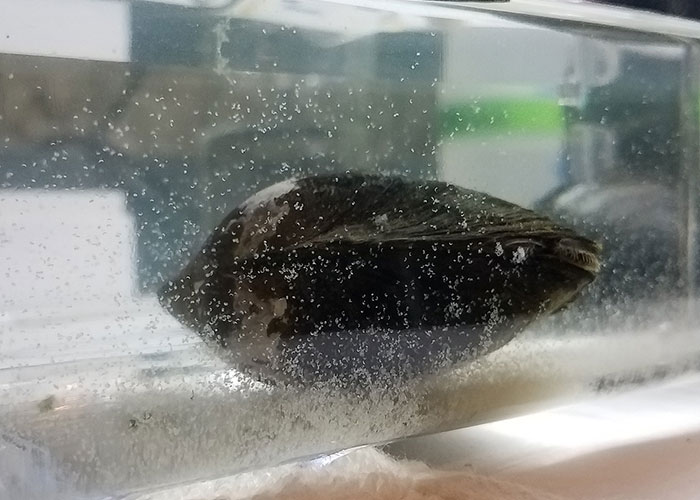 Female Alewife Floater at The Mussel Hatchery at the FWW. Floating about are thousands of young mussels (glochidia), just discharged, that will eventually attach to fish gills and fins. Credit: Lance Butler
Female Alewife Floater at The Mussel Hatchery at the FWW. Floating about are thousands of young mussels (glochidia), just discharged, that will eventually attach to fish gills and fins. Credit: Lance Butler
Freshwater mussels also have a very unusual life cycle. Unlike their estuarine cousins, clams and oysters, who broadcast their young directly into the water column, most freshwater mussels need fish to complete the cycle. When the adult female senses a fish is very close, it quickly expels the larval mussels (glochidia) from her swollen gills, frequently enveloping the fish in a living cloud of baby mussels.
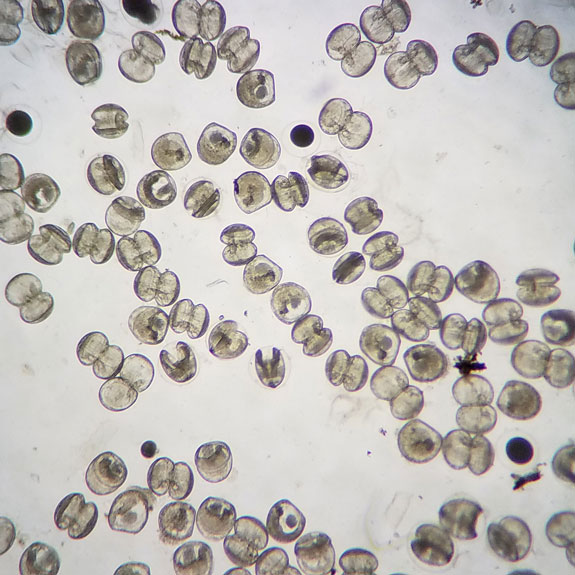 Glochidia up close. Credit: Lance Butler
Glochidia up close. Credit: Lance Butler
Mussels that encounter the fish’s fins or gills tightly close their shells and attach to the fish. For several weeks, the tiny hitchhikers grow larger until they are big enough to live on their own. They eventually let go of the fish, settle to the bottom, where they pull themselves into the sediments and, soon thereafter, start to filter river water.
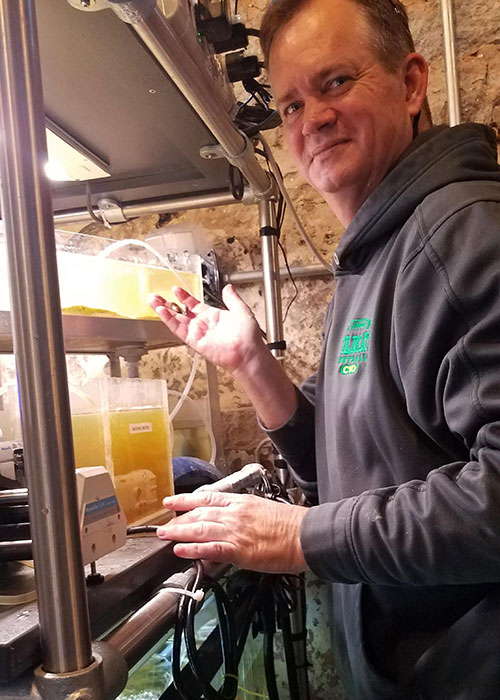 PWD Senior Scientist, Lance Butler, checking on the development of the juvenile mussels in The Mussel Hatchery at the FWW. Credit: PWD
PWD Senior Scientist, Lance Butler, checking on the development of the juvenile mussels in The Mussel Hatchery at the FWW. Credit: PWD
Unfortunately, the COVID pandemic has delayed several of our programs. With limited staffing and access, PDE, PWD and Academy researchers have been able to cautiously prepare for the next round of mussel propagation at the hatchery. Hopefully, we will be able to catch up on these projects before too long, produce more young mussels, and continue to develop a comprehensive plan for restoring some of these mussels to areas where they were historically abundant.
These research programs are successful due, in large part, to the efforts of the many current and former BEES department undergraduate and graduate students, co-ops and alumni working at the Academy, and PDE and PWD, who have been an integral part of the field teams. They truly reflect the goal of our BEES motto “Field Experience, Early and Often.” They are bright, inquisitive, team-oriented, and very well prepared to tackle the varied challenges, whether under the blistering sun on the Delaware River, in the biting winter winds on Green Lane Reservoir or during countless long hours in the lab. Many thanks to those featured in our field and lab photos! Students and staff over the recent years include Shannon Boyle, Kelsey Capobianco, Amanda Chan, Kurt Cheng, Cam Chung, Stephen Dench, Mary Donnelly, Julia Duriske, Jonathan Galuchie, Matt Gentry, Matt Gray, Frankie Lazauskus, Alex Leszczynski, Kathryn Longwill, Malcolm Newman, Spencer Roberts, Chris Vito, Lindsey White, Lexi Wysocki, and Jakub Zegar.